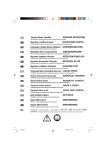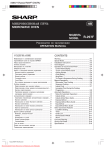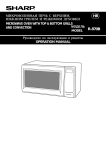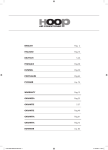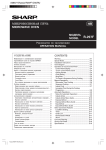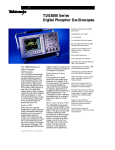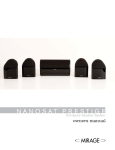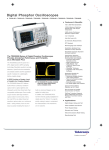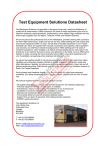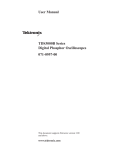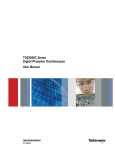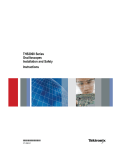Download Manual - TMG Test Equipment
Transcript
TDS3BAT
Rechargeable Battery Pack
Instructions
071-0368-01
Recharge battery properly. Recharge the battery
pack only for the recommended charge cycle at
the recommended temperature.
Use proper battery charger. Use only the
TDS3CHG or the TDS3000/TDS3000B series
oscilloscope to charge the TDS3BAT battery pack.
Do not operate without covers. Do not operate this
product with covers or panels removed.
Do not operate with suspected failures. If you
suspect there is damage to this product, have it
inspected by qualified service personnel.
Provide proper ventilation. Refer to the installation
instructions in the TDS3000/TDS3000B Series
User Manual for details on installing the product
so it has proper ventilation.
Do not operate in wet/damp conditions.
Do not operate in an explosive atmosphere.
Keep product surfaces clean and dry.
Safety terms in this manual
CAUTION. These statements identify
conditions or practices that could result in
damage to the equipment or other property.
Description
The TDS3BAT is for use with
TDS3000/TDS3000B Series oscilloscopes. The
12 VDC battery pack consists of an array of
NiCad battery cells with a built in charger and
gauge.
Removing the Battery Pack
To remove the battery pack, follow these steps:
1. Open the battery compartment door.
Safety symbols on the product
CAUTION
Refer to Manual
1
*P071036801*
071036801
Safety Summary
To avoid potential hazards, use this product only
as specified.
To avoid fire or personal injury
Ground the product. For safe operation, the oscilloscope chassis must remain at earth ground potential even when operating from battery power. This
protection is provided when you attach the Tektronix-supplied grounding wire from the terminal on
the rear panel of the oscilloscope to earth ground.
If you use a different grounding wire, it must be
18 gauge or larger.
Double
Insulated
Protective Ground
(Earth) Terminal
Battery recycling
This product contains a Nickel Cadmium (NiCad)
battery, which must be recycled or disposed of
properly. For the location of a local battery
recycler in the U.S. or Canada, please contact:
RBRC
Rechargeable Battery Recycling Corp.
P.O. Box 141870
Gainesville, Florida 32614
(800) BATTERY (800) 227-7379
http://www.rbrc.com
2. Raise the handles on each side of the battery
pack and use them to pull the battery pack out
of the oscilloscope.
Charging the Battery Pack
The battery pack charges automatically when the
oscilloscope is connected to line power. For a
more efficient charge, use the optional external
charger (TDS3CHG).
When the battery pack is in the oscilloscope, the
gauge icon (
) on the display indicates the
amount of charge.
S To avoid automatic shutdown of the battery
pack, run the oscilloscope on the battery pack
only when the gauge indicates sufficient
charge.
S
NiCad batteries appear to lose capacity if not
allowed to occasionally discharge completely.
Every few months, run your oscilloscope until it
shuts down and then recharge the battery pack
completely to keep your battery pack at peak
performance.
To discharge the battery pack completely, continue
to run the oscilloscope on the battery pack until
automatic shutdown occurs. The display may turn
white a few minutes before the automatic
shutdown to allow the oscilloscope to completely
discharge the battery pack.
NOTE. To prolong the life of the battery pack
and to prevent shutdown, do not operate or
charge the battery pack at high
temperatures. For best results, allow the
battery pack to cool to room temperature
before using or charging the battery pack.
To ensure the accuracy of the gauge, occasionally allow the oscilloscope to run on the battery pack until automatic shutdown occurs.
NOTE. The TDS3CHG external charger may
increase the available charge and reset the
gauge to a higher level. Subsequent charges
using the oscilloscope may indicate less than
a full charge.
Configuration
Typical charging time
18 hours
Battery pack charging in
oscilloscope with
oscilloscope turned on or off
Battery pack charging with
TDS3CHG external charger
The battery pack stops charging under the
following conditions:
S The battery pack is fully charged
S
The battery pack temperature exceeds +45 _C
S
The charge time exceeds 4.5 hours when
charging with the TDS3CHG
S
The charge time exceeds 24 hours when
charging in the TDS3000/TDS3000B series
oscilloscope.
4 hours
CAUTION. To avoid damage to the battery
pack, use only the oscilloscope or the
TDS3CHG battery charger to charge the
battery pack. Do not connect any other
voltage source to the battery pack.
The battery pack shuts down and disconnects
itself from the TDS3000/TDS3000B series
oscilloscope under the following conditions:
S The battery pack is fully discharged
S
There is a fault current in excess of 7A
S
The temperature inside the battery pack
compartment exceeds 70 _C
Replaceable Parts
Grounding wire
174-3997-00
Specifications
Optional
TDS3CHG
NOTE. Charge the battery pack completely
before using it for the first time or after
prolonged storage. Several charge/discharge
cycles may be required before the battery
pack can charge to its full capacity.
www.tektronix.com
Input from
TDS3CHG
30 W, 18 VDC, 1.8 A (current limited)
Output
12 VDC, 4400 mAh
Operating
Temperature
5 °C to 50 °C , discharging
0 °C to 45 °C , charging
Storage
Temperature
- 30 °C to +50 °C, short term
- 20 °C to +35 °C, long term (greater
than 3 months
Temperature
Coefficient
0.2 x (specified accuracy) /°C
(<18 °C or >28 °C)
Certifications and compliances
Australia/New Zealand Declaration of Conformity - EMC
Complies with EMC provision of Radiocommunications Act
per the following standard(s):
AS/NZS 2064.1/2
Industrial, Scientific, and Medical
Equipment: 1992
EC Declaration of
Conformity EMC
Meets the intent of Directive
89/336/EEC for Electromagnetic
Compatibility when it is used with the
product(s) stated in the specifications
table. Refer to the EMC specification
published for the stated product. May
not meet the intent of the directive if
used with other products.
FCC Compliance
- EMC
Emissions comply with FCC Code of
Federal Regulations 47, Part 15,
Subpart B, Class A Limits.
WARRANTY SUMMARY
Tektronix warrants that the products that it
manufactures and sells will be free from defects in
materials and workmanship for a period of three
(3) months from the date of shipment from an
authorized Tektronix distributor. If a product or
CRT proves defective within the respective period,
Tektronix will provide repair or replacement as
described in the complete warranty statement.
To arrange for service or obtain a copy of the
complete warranty statement, please contact your
nearest Tektronix sales and service office.
EXCEPT AS PROVIDED IN THIS SUMMARY
OR THE APPLICABLE WARRANTY
STATEMENT, TEKTRONIX MAKES NO
WARRANTY OF ANY KIND, EXPRESS OR
IMPLIED, INCLUDING WITHOUT
LIMITATION THE IMPLIED WARRANTIES
OF MERCHANTABILITY AND FITNESS FOR
A PARTICULAR PURPOSE. IN NO EVENT
SHALL TEKTRONIX BE LIABLE FOR
INDIRECT, SPECIAL OR CONSEQUENTIAL
DAMAGES.
Maximum Altitude 2000 m
Copyright Tektronix, Inc.
Beaverton, OR 97077
Instructions relatives à la
batterie rechargeable
TDS3BAT
071-0368-01
Recharger la batterie correctement. Rechargez la
batterie en vous référant uniquement au cycle de
charge et à la température préconisés.
Utiliser le chargeur de batterie approprié. N’utilisez
que le TDS3CHG ou l’oscilloscope modèle
TDS3000/TDS3000B pour charger la batterie
TDS3BAT.
Description
Ne pas utiliser sans les caches de protection.
N’utilisez pas le présent produit sans les caches de
protection et les panneaux.
Ne pas utiliser en cas de défaillances suspectes. En
cas de doute concernant l’état du présent produit,
faites-le contrôler par un personnel de
maintenance qualifié.
Assurer une ventilation adéquate. Pour de plus
amples informations sur l’installation du produit
assurant une ventilation adéquate, reportez-vous
aux instructions d’installation du Manuel de
l’utilisateur de l’oscilloscope modèle
TDS3000/TDS3000B.
Ne pas utiliser dans un environnement humide.
La batterie rechargeable TDS3BAT est utilisée
avec les oscilloscopes modèle
TDS3000/TDS3000B. La batterie 12 volts est
constituée d’un ensemble de piles nickel-cadmium
et comporte un chargeur et une jauge.
Instructions pour retirer la batterie
Pour retirer la batterie, procédez comme suit :
1. Ouvrez le logement de la batterie.
Ne pas utiliser dans un environnement contenant des
explosifs.
Conserver les surfaces propres et sèches.
Termes relatifs à la sécurité apparaissant dans
ce manuel.
ATTENTION. Ces messages identifient les
conditions ou les actions susceptibles de
provoquer des dommages vis-à-vis du
présent produit ou d’autres équipements.
2
Symboles relatifs à la sécurité apparaissant sur
le produit
Consignes de sécurité
Afin d’éviter tout danger potentiel, n’utilisez ce
produit que dans les conditions spécifiées.
Pour éviter les incendies et les dommages
corporels
Mettre l’appareil à la terre. Pour votre sécurité, le
châssis de l’oscilloscope doit toujours être mis à la
terre, même lorsqu’il fonctionne à partir de la
batterie. Vous disposez de cette protection en
reliant le câble de masse, fourni par Tektronix, de
la terminaison située sur le panneau arrière de
l’oscilloscope à la terre. Si vous utilisez un câble
de masse différent, son calibre doit être égal à 18
au moins.
ATTENTION
Reportez-vous
au manuel
Double
isolation
Mise à la masse
Terminaison à la terre
Recyclage de la batterie
Le présent produit contient une batterie nickelcadmium (NiCad) qui doit être recyclée ou
détruite de manière adéquate. Pour connaître
l’adresse d’une entreprise locale spécialisée dans le
recyclage de batteries aux Etats-Unis ou au
Canada, veuillez vous adresser à :
RBRC
Rechargeable Battery Recycling Corp.
P.O. Box 141870
Gainesville, Florida 32614
(800) BATTERY (800) 227-7379
http://www.rbrc.com
2. Retirez la batterie de l’oscilloscope à l’aide des
poignées situées de part et d’autre de
l’oscilloscope.
Mise en charge de la batterie
La charge de la batterie s’effectue
automatiquement lorsque l’oscilloscope
fonctionne sur secteur. Pour assurer une charge
plus efficace, utilisez le chargeur externe
(TDS3CHG) fourni en option.
Lorsque la batterie est insérée dans l’oscilloscope,
l’icône de jauge ( ) apparaissant sur l’affichage
indique l’état de charge.
S
Pour éviter une coupure automatique de la
batterie, faites fonctionner l’oscilloscope à
partir de la batterie uniquement lorsque le
témoin indique une charge suffisante.
S
Pour assurer la précision de la jauge, faites
régulièrement fonctionner l’oscilloscope avec
la batterie jusqu’à ce qu’il s’éteigne automatiquement.
Les batteries NiCad perdent de leur capacité si
elles ne sont pas régulièrement déchargées
entièrement. Après quelques mois d’utilisation,
faites fonctionner votre oscilloscope jusqu’à ce
qu’il s’éteigne, puis rechargez la batterie
entièrement afin qu’elle conserve sa capacité
totale. Répétez cette opération régulièrement.
Pour décharger la batterie entièrement, continuez
de faire fonctionner l’oscilloscope à partir de la
batterie jusqu’à ce qu’il s’éteigne automatiquement. L’affichage peut devenir blanc quelques
minutes avant l’arrêt automatique de manière à ce
que l’oscilloscope décharge entièrement la
batterie.
REMARQUE. Pour prolonger la durée de vie
de la batterie et éviter des coupures,
n’utilisez pas et ne chargez pas la batterie à
des températures élevées. Pour assurer de
meilleures performances, laissez la batterie
refroidir à une température ambiante avant
de l’utiliser ou de la mettre en charge.
REMARQUE. Le chargeur externe TDS3CHG
peut augmenter la charge disponible et
régler la jauge à un niveau plus élevé. Les
charges ultérieures en utilisant l’oscilloscope
peuvent indiquer un niveau de charge
incomplet.
Configuration
Temps de charge effectif
Batterie en charge dans
l’oscilloscope, oscilloscope
sous tension ou hors
tension
18 heures
Batterie en charge avec le
chargeur externe
TDS3CHG
4 heures
S
La batterie est entièrement chargée.
S
La température de la batterie dépasse 45°C.
S
Le temps de charge dépasse 4,5 heures lorsque
vous utilisez le TDS3CHG.
S
Le temps de charge dépasse 24 heures lorsque
vous utilisez l’oscilloscope modèle
TDS3000/TDS3000B.
S
La batterie est entièrement déchargée.
S
Le courant de défaut dépasse de 7 A.
S
La température à l’intérieur du logement de la
batterie dépasse 70°C.
Pièces remplaçables
Câble de masse
174-3997-00
Spécifications
Chargeur
TDS3CHG en
option
REMARQUE. Chargez la batterie entièrement
avant une première utilisation ou après une
longue période d’interruption. Plusieurs
cycles de charge et de décharge peuvent être
nécessaires avant que la batterie ne puisse
assurer une capacité de charge maximale.
Déclaration de conformité EMC concernant l’Australie et la
Nouvelle-Zélande
Conforme à la disposition EMC du Radiocommunications
Act relative à la (aux) norme(s) suivante(s) :
AS/NZS 2064.1/2
Equipement industriel, médical,
scientifique : 1992
Déclaration de
conformité EMC
concernant la CE
Conforme à la directive 89/336/CEE
relative à la compatibilité
électromagnétique lors de l’utilisation
avec le(s) produit(s) mentionné(s)
dans le tableau des spécifications. Fait
référence à la spécification EMC
publiée pour le produit spécifié.
Possibilité de non-conformité à la
directive en cas d’utilisation avec
d’autres produits.
Conformité FCC
– EMC
Les émissions sont conformes au
Code FCC n° 47, partie 15,
sous–partie B, limites de classe A.
La charge de la batterie est interrompue dans les
cas suivants :
La batterie s’éteint et se déconnecte de
l’oscilloscope modèle TDS3000/TDS3000B dans
les cas suivants :
ATTENTION. Pour éviter d’endommager la
batterie, utilisez uniquement l’oscilloscope
ou le chargeur externe TDS3CHG pour la
mettre en charge. Ne reliez aucune autre
source de tension à la batterie.
Certifications et conformités
Alimentation à partir
du TDS3CHG
30 W, 18 V (courant continu),
1,8 A (courant limité)
Sortie
12 V (courant continu), 4400 mAh
Température de
fonctionnement
de 5°C à 50°C en déchargede
0°C à 45°C en charge
Température de
stockage
de - 30°C à +50°C, faible durée
de - 20°C à +35°C, longue durée
(supérieure à 3 mois)
Coefficient de
température
0,2 x (précision spécifiée) /°C
(<18°C ou >28°C)
Altitude maximale
2000 m
RESUME DE LA GARANTIE
Tektronix garantit que les produits qu’elle
fabrique et commercialise sont exempts de tout
défaut de matériau ou vice de fabrication pendant
une période de trois (3) mois, à compter de la date
de livraison par un distributeur Tektronix agréé. Si
un produit ou un tube cathodique s’avérait
défectueux pendant cette période de garantie,
Tektronix s’engage à procéder, soit à la réparation,
soit au remplacement du produit, tel que le prévoit
le texte original de la garantie.
Pour faire appel à nos services de maintenance ou
obtenir un exemplaire original de la garantie,
contactez votre bureau de vente et le service
après-vente Tektronix le plus proche.
HORMIS LE PRESENT RESUME ET LA
DECLARATION DE GARANTIE
APPLICABLE, TEKTRONIX REFUTE TOUTE
GARANTIE, EXPLICITE OU IMPLICITE,
Y COMPRIS SANS LIMITATION DES
GARANTIES IMPLICITES DE COMMERCIALISATION OU D’APTITUDE A DES FINS
SPECIFIQUES. EN AUCUN CAS TEKTRONIX
NE POURRA ETRE TENUE RESPONSABLE
DE DOMMAGES INDIRECTS OU
SPECIFIQUES.
Copyright Tektronix, Inc.
Beaverton, OR 97070
Istruzioni per il
gruppo batterie ricaricabile
TDS3BAT
071-0368-01
Ricaricare le batterie correttamente. Ricaricare il
gruppo batterie solo per il ciclo di ricarica consigliato e alla temperatura raccomandata.
Utilizzare il caricabatteria appropriato. Utilizzare
esclusivamente il TDS3CHG o gli oscilloscopi
serie TDS3000/TDS3000B per ricaricare il gruppo batterie TDS3BAT.
Descrizione
Non mettere in funzione il prodotto senza pannelli o
coperchi. Non mettere in funzione questo prodotto
se sono stati rimossi pannelli o coperchi.
Non mettere in funzione il prodotto in presenza di
presunti malfunzionamenti. In caso di presunto
malfunzionamento, sottoporre il prodotto
all’esame di personale qualificato.
Fornire la ventilazione appropriata. Consultare le
istruzioni di installazione presenti nel Manuale
dell’utente Serie TDS3000/TDS3000B per i
dettagli su come installare il prodotto affinché
abbia la ventilazione adeguata.
Il TDS3BAT è concepito per l’uso con
oscilloscopi serie TDS3000/TDS3000B. Il gruppo
batterie da 12 V CC consiste in una serie di
elementi al nichel cadmio con caricabatteria e
indicatore incorporati.
Non mettere in funzione il prodotto se umido o
bagnato.
Per rimuovere il gruppo batterie attenersi ai
seguenti passi:
1. Aprire lo sportello del comparto batterie.
Non mettere in funzione il prodotto in ambienti a
rischio di esplosione.
Rimozione del gruppo batterie
Mantenere le superfici del prodotto pulite e asciutte.
Termini di sicurezza presenti in questo manuale.
CAUTELA. Termine che identifica condizioni o
operazioni che potrebbero causare danni
all’apparecchiatura o ad altri oggetti.
Simboli di sicurezza presenti sul prodotto
2. Sollevare le maniglie poste su entrambi i lati
del gruppo batterie ed utilizzarle per estrarre il
gruppo batterie dall’oscilloscopio.
3
Regole di sicurezza
Per evitare potenziali rischi, utilizzare questo
prodotto attenendosi esclusivamente alle
informazioni specificate.
Per evitare incendi o lesioni alle persone
Eseguire il collegamento a terra del prodotto. Per un
funzionamento sicuro è necessario che il telaio
dell’oscilloscopio rimanga connesso a terra anche
durante l’alimentazione a batterie. Tale protezione
viene fornita connettendo il terminale del pannello
posteriore dell’oscilloscopio alla presa di terra con
l’apposito cavo di terra fornito da Tektronix.
Qualora si desiderasse impiegare cavi differenti,
utilizzare diametri 18 o superiori.
CAUTELA
Fare riferimento
al manuale
Isolamento
doppio
Terminale protezione
messa a terra (massa)
Riciclaggio delle batterie
Questo prodotto contiene una batteria al nichel
cadmio (NiCad), che dovrà essere riciclata o
smaltita in modo adeguato. Per informazioni su
un riciclatore di batterie locale negli U.S.A. o
in Canada, contattare:
RBRC
Rechargeable Battery Recycling Corp.
P.O. Box 141870
Gainesville, Florida 32614
(800) BATTERY (800) 227-7379
http://www.rbrc.com
Ricarica del gruppo batterie
Il gruppo batterie si ricarica automaticamente
quando l’oscilloscopio viene connesso alla linea di
alimentazione. Per una ricarica più efficiente,
utilizzare il caricabatteria opzionale esterno
(TDS3CHG).
Quando il gruppo batterie è all’interno
dell’oscilloscopio, l’icona dell’indicatore presente
sul display (
) mostra il livello di carica.
S Per evitare l’arresto automatico del gruppo
batterie, mettere in funzione l’oscilloscopio
mediante alimentazione a batteria solo nei casi
in cui l’indicatore rivela una carica sufficiente.
S
Le batterie al nichel cadmio perdono capacità se,
di tanto in tanto, non vengono lasciate scaricarsi
completamente. Ad intervalli di qualche mese,
pertanto, lasciare acceso l’oscilloscopio fino
all’esaurimento della carica e successivamente
ricaricare completamente il gruppo batterie per
mantenerlo alle massime prestazioni.
Per scaricare completamente il gruppo batterie,
lasciare in funzione l’oscilloscopio, alimentato
mediante il gruppo batterie, fino al verificarsi dello
spegnimento automatico. Alcuni minuti prima
dello spegnimento automatico, il display potrebbe
diventare bianco per consentire all’oscilloscopio
di esaurire completamente il gruppo batterie.
NOTA. Per prolungare la durata del gruppo
batterie e prevenire interruzioni, non mettere
in funzione né ricaricare il gruppo batterie
ad alte temperature. Per ottenere i risultati
migliori, lasciare che il gruppo batterie si
raffreddi fino a raggiungere la temperatura
ambiente prima di usarlo o di ricaricarlo.
Per garantire la precisione dell’indicatore,
lasciare di tanto in tanto l’oscilloscopio in
funzione mediante alimentazione a batteria
fino al verificarsi dell’arresto automatico.
NOTA. Il caricabatteria esterno TDS3CHG
potrebbe aumentare la carica disponibile e
reimpostare l’indicatore ad un livello
superiore. Le ricariche successive mediante
oscilloscopio potrebbero indicare un livello
di ricarica inferiore a quello massimo.
Configurazione
Tempo di ricarica tipico
Gruppo batterie in ricarica
nell’oscilloscopio con
l’oscilloscopio acceso o
spento
18 ore
Gruppo batterie in ricarica
con il caricabatteria esterno
TDS3CHG
4 ore
CAUTELA. Per evitare danni al gruppo
batterie, utilizzare solo l’oscilloscopio o il
caricabatteria TDS3CHG per ricaricarlo.
Non collegare nessun altra fonte di corrente
al gruppo batterie.
Il gruppo batterie non viene ricaricato se si
verificano le seguenti condizioni:
S Il gruppo batterie è completamente carico.
S
La temperatura del gruppo batterie supera i
+45_ C.
S
Il tempo di ricarica supera le 4,5 ore, quando
si utilizza il TDS3CHG.
S
Il tempo di ricarica, all’interno dell’oscilloscopio serie TDS3000/TDS3000B, supera le
24 ore.
Il gruppo batterie si spegne e si disconnette
automaticamente dall’oscilloscopio serie
TDS3000 se si verificano le seguenti condizioni:
S Il gruppo batterie è completamente scarico.
S
Vi è una corrente di terra in eccesso di 7A.
S
La temperatura all’interno dello scomparto del
gruppo batterie supera i 70_ C.
Parti sostituibili
Cavo di terra
174-3997-00
Specifiche
TDS3CHG
opzionale
NOTA. Caricare il gruppo batterie
completamente prima di utilizzarlo per la
prima volta o dopo un prolungato periodo
di inattività. Potrebbero essere necessari più
cicli di ricarica/scarica prima che il gruppo
batterie possa caricarsi alla sua massima
capacità.
Ingresso da
TDS3CHG
30 W, 18 V CC, 1,8 A (limitato da
corrente)
Uscita
12 V CC, 4400 mAh
Temperatura di
esercizio
Da 5 °C a 50 °C, scarica
Da 0 °C a 45 °C, ricarica
Temperatura per
la conservazione
Da –30 °C a +50 °C, per periodi brevi
Da –20° C a +35 °C, per periodi lunghi
(superiori a 3 mesi)
Coefficiente di
temperatura
0,2 x (precisione specificata) /°C
(<18 °C o >28 °C)
Altitudine
massima
2000 m
Certificati e conformità
Australia/Nuova Zelanda: Dichiarazione di conformità –
EMC
Conforme alle disposizioni EMC del Radiocommunications
Act per gli standard seguenti:
AS/NZS 2064.1/2
Apparecchiature industriali,
scientifiche e mediche: 1992
Dichiarazione di
conformità della
Comunità
Europea – EMC
Conforme agli intenti della direttiva
89/336/EEC per la Compatibilità
elettromagnetica se usato con il o i
prodotti elencati nella tabella delle
specifiche. Fare riferimento alle
specifiche EMC pubblicate relative ai
prodotti specificati. Potrebbe non
essere conforme agli intenti della
direttiva se utilizzato con altri prodotti.
Conformità alle
norme FCC –
EMC
Le emissioni sono conformi al codice
FCC delle Norme federali 47, Parte
15, Sottoparte B, limiti di Classe A.
GARANZIA
La Tektronix garantisce che i prodotti da essa
realizzati e venduti saranno esenti da difetti di
materiale e di fabbricazione per un periodo di tre
(3) mesi con decorrenza dalla data di spedizione
da un distributore autorizzato Tektronix. Se un
prodotto o CRT presenta difetti durante detto
periodo, la Tektronix riparerà il prodotto, o lo
sostituirà, secondo quanto disposto nella
dichiarazione completa di garanzia.
Per richiedere assistenza o per ottenere una copia
della dichiarazione completa di garanzia,
contattare l’ufficio vendite o il centro di assistenza
Tektronix più vicini.
AD ECCEZIONE DI QUANTO DISPOSTO
IN QUESTO RIEPILOGO O NELLA
DICHIARAZIONE DI GARANZIA
APPLICABILE, LA TEKTRONIX ESCLUDE
QUALSIASI GARANZIA, ESPLICITA O
IMPLICITA, INCLUSE SENZA LIMITAZIONE
LE GARANZIE IMPLICITE DI COMMERCIABILITÀ E IDONEITÀ A SCOPI SPECIFICI.
IN NESSUN CASO LA TEKTRONIX POTRÀ
ESSERE RITENUTA RESPONSABILE DI
QUALSIASI DANNO INDIRETTO, SPECIALE
O CONSEQUENZIALE.
Copyright Tektronix, Inc.
Beaverton, OR 97070
Akku
TDS3BAT
Betriebsanleitung
071-0368-01
Laden Sie den Akku ordnungsgemäß auf. Laden Sie
den Akku nur für die angegebene Zeit und im
empfohlenen Temperaturbereich auf.
Verwenden Sie das richtige Ladegerät. Verwenden
Sie nur das Ladegerät TDS3CHG oder ein Oszilloskop der Serie TDS3000/TDS3000B, um den
Akku TDS3BAT zu laden.
Beschreibung
Betreiben Sie das Gerät nicht ohne Abdeckungen.
Betreiben Sie dieses Produkt nicht, wenn Abdeckungen entfernt wurden.
Betreiben Sie das Gerät nicht, wenn Fehler aufgetreten sind. Wenn Sie vermuten, daß das Produkt
beschädigt wurde, lassen Sie es von einem qualifizierten Wartungstechniker untersuchen.
Sorgen Sie für ausreichende Luftzufuhr. Informationen zur Installation des Produkts in Umgebungen
mit ausreichender Luftzirkulation finden Sie im
Benutzerhandbuch zum TDS3000/TDS3000B.
Betreiben Sie das Gerät nicht in feuchter oder nasser
Umgebung.
Betreiben Sie das Gerät nicht in Umgebungen mit
explosiven Gasen.
Der TDS3BAT wurde für den Einsatz in
Oszilloskopen der Serie TDS3000/TDS3000B
entworfen. Der Akku (12 V Gleichstrom) besteht
aus mehreren NiCad-Akkuzellen mit integriertem
Lader und integrierter Kapazitätsanzeige.
Entnehmen des Akkus
Führen Sie die folgenden Schritte durch, um den
Akku zu entnehmen:
1. Öffnen Sie die Abdeckung des Akkufachs.
Halten Sie die Oberflächen des Produkts sauber und
trocken.
Sicherheitshinweise in diesem Handbuch
VORSICHT. Diese Darstellungen beschreiben
Bedingungen oder Vorgehensweisen, die zur
Beschädigung des Produkts oder anderen
Eigentums führen können.
Sicherheitssymbole auf dem Produkt
4
VORSICHT
Siehe Handbuch
Sicherheitshinweise
Nutzen Sie dieses Produkt unter Beachtung der
zugehörigen Anweisungen, um Unfälle und
andere Gefahren zu vermeiden.
Vermeiden von Feuer und Verletzungen
Erden Sie das Gerät. Um den sicheren Betrieb zu
gewährleisten, muß das Gehäuse des Oszilloskops
auch im Akkubetrieb geerdet sein. Diese Erdung
wird erreicht, indem Sie das mitgelieferte
Tektronix-Erdungskabel mit dem Anschluß auf
der Rückseite verbinden und dann erden. Wenn
Sie ein anderes Erdungskabel verwenden, muß es
eine Kapazität von 18 Gauge oder mehr
aufweisen.
Doppelte
Abschirmung
Schutzleiteranschluß
Akku-Recycling
Dieses Produkt enthält einen Nickel-CadmiumAkku (NiCad), der ordnungsgemäß entsorgt
werden muß. Informationen zu einem lokalen
Recyclingunternehmen in den USA und in
Kanada erhalten Sie unter folgender Adresse:
RBRC
Rechargeable Battery Recycling Corp.
P.O. Box 141870
Gainesville, Florida 32614
(800) BATTERY (800) 227-7379
http://www.rbrc.com
2. Heben Sie die Griffe an den Seiten des Akkus
an, und ziehen Sie den Akku an diesen Griffen
aus dem Oszilloskop.
Laden des Akkus
Der Akku wird automatisch geladen, wenn das
Oszilloskop an das Stromnetz angeschlossen ist.
Effizienteres Laden ist mit dem optionalen
externen Ladegerät TDS3CHG möglich.
Wenn sich der Akku im Oszilloskop befindet,
zeigt das Kapazitätssymbol ( ) in der Anzeige
die verbleibende Restladung an.
S
Betreiben Sie das Oszilloskop nur mit dem
Akku, wenn die Kapazitätsanzeige auf
ausreichende Ladung hinweist. Andernfalls
schaltet sich das Gerät automatisch aus.
S
Um die Genauigkeit der Kapazitätsanzeige
sicherzustellen, sollten Sie den Akku
gelegentlich vollständig entladen, indem Sie
das Oszilloskop betreiben, bis es sich
selbsttätig ausschaltet.
NiCad-Akkus scheinen Kapazität zu verlieren,
wenn sie nicht gelegentlich vollständig entladen
werden. Lassen Sie das Oszilloskop nach jeweils
einigen Monaten so lange laufen, bis es sich
ausschaltet. Laden Sie anschließend den Akku.
Dieses Vorgehen erhält die ursprüngliche
Kapazität des Akkus.
Sie können den Akku vollständig entladen, indem
Sie das Oszilloskop laufen lassen, bis es sich
wegen Strommangels selbsttätig ausschaltet. Die
Anzeige wird möglicherweise bereits einige
Minuten vor dem selbsttätigen Ausschalten des
Oszilloskops weiß. Warten Sie trotzdem, bis sich
das Gerät automatisch ausschaltet.
Konfiguration
Normale Ladezeiten
Akku wird bei ein- oder
ausgeschaltetem Oszilloskop im
Oszilloskop geladen
18 Stunden
Akku wird mit dem externen
Ladegerät TDS3CHG geladen
4 Stunden
VORSICHT. Der Akku darf nur im Oszilloskop
oder mit dem Ladegerät TDS3CHG geladen
werden, um Beschädigungen zu vermeiden.
Schließen Sie den Akku nicht an andere
Stromquellen an.
des Akkus bei hohen Temperaturen, um die
Lebensdauer des Akkus zu erhöhen und ein
automatisches Ausschalten des Geräts zu
verhindern. Lassen Sie den Akku auf
Zimmertemperatur abkühlen, bevor Sie ihn
laden oder verwenden.
Der Akku bricht das Laden unter folgenden
Bedingungen ab:
S
Der Akku ist vollständig geladen.
S
Die Temperatur des Akkus liegt über +45_ C.
S
Die Ladezeit mit dem TDS3CHG übersteigt
4,5 Stunden.
S
Die Ladezeit im Oszilloskop der Serie
TDS3000 überschreitet 24 Stunden.
Der Akku unterbricht den Ladevorgang im
Oszilloskop der Serie TDS3000 unter folgenden
Bedingungen automatisch:
S
Der Akku ist vollständig entladen.
S
Der Fehlerstrom übersteigt 7 A.
S
Die Temperatur im Akkufach übersteigt 70_ C.
Austauschbare Teile
Erdungskabel
174-3997-00
Technische Daten
Optionales Ladegerät
TDS3CHG
HINWEIS. Laden Sie den Akku nach längerer
Lagerung und vor dem ersten Einsatz
vollständig auf. Der Akku muß gegebenenfalls mehrmals ge- und entladen werden,
bevor der Akku mit voller Kapazität geladen
werden kann.
Konformitätsdeklaration für Australien/Neuseeland – EMC
Entspricht den Richtlinien zur elektromagnetischen
Verträglichkeit im Radiocommunications Act nach
Maßgabe folgender Standards:
AS/NZS 2064.1/2
Industrial, Scientific, and Medical
Equipment: 1992
EU-Konformitätsdeklaration –
EMC
Entspricht dem Inhalt der Direktive
89/336/EEC zur elektromagnetischen
Verträglichkeit, wenn es mit den in
der Tabelle angegebenen Produkten
eingesetzt wird. Beachten Sie die für
das Produkt veröffentlichten EMCSpezifikationen. Die Einhaltung der
Richtlinie ist nicht gewährleistet,
wenn es mit anderen Produkten
eingesetzt wird.
FCC Compliance –
EMC
Die Emissionen entsprechen dem
FCC Code in Federal Regulations 47,
Part 15, Subpart B, Class A Limits.
HINWEIS. Vermeiden Sie Aufladen und Nutzen
HINWEIS. Das externe Ladegerät TDS3CHG
kann die Ladung erhöhen und zu einer
höheren Anzeige im Kapazitätssymbol
führen. Finden spätere Ladungen im
Oszilloskop statt, wird der Akku
gegebenenfalls nicht vollständig geladen.
Zertifikate und Richtlinien
Stromaufnahme aus
dem TDS3CHG
30 W, 18 V Gleichstrom, 1,8 A (mit
Strombegrenzung)
Ausgang
12 V Gleichstrom, 4400 mAh
Betriebstemperatur
5 °C bis 50 °C beim Entladen
0 °C bis 45 °C beim Laden
Lagertemperatur
–30 °C bis +50 °C, kurzfristig
–20 °C bis +35 °C, mehr als drei
Monate
Temperaturkoeffizient
0,2 x (angegebene Genauigkeit) /°C
(<18°C oder >28°C)
Maximale
Betriebshöhe
2000 m
GEWÄHRLEISTUNG
Tektronix gewährleistet die Fehlerfreiheit
hinsichtlich Material und Verarbeitung der von
Tektronix hergestellten und vertriebenen Produkte
für die Dauer von drei (3) Monaten nach dem
Verkauf durch einen autorisierten TektronixHändler. Weist ein Produkt oder CRT in diesem
Zeitraum einen Fehler auf, repariert Tektronix das
Gerät oder tauscht es nach Maßgabe der
Bedingungen in der vollständigen Gewährleistungsvereinbarung aus.
Wenden Sie sich an die nächstgelegene
Tektronix-Vertriebsniederlassung, um diese
Leistung in Anspruch zu nehmen oder eine Kopie
der Gewährleistungsvereinbarung anzufordern.
AUSSER DEN IN DIESER KURZFASSUNG
UND DEN IN DER AUSFÜHRLICHEN
GEWÄHRLEISTUNGSVEREINBARUNG
ERLÄUTERTEN ANSPRÜCHEN
ÜBERNIMMT TEKTRONIX KEINERLEI
GEWÄHRLEISTUNG IRGENDWELCHER
ART, EINSCHLIESSLICH – OHNE DARAUF
BESCHRÄNKT ZU SEIN – DER
HANDELSÜBLICHKEIT UND DER
EIGNUNG FÜR EINEN BESTIMMTEN
ZWECK. IN KEINEM FALL HAFTET
TEKTRONIX FÜR INDIREKTE, SPEZIELLE
ODER FOLGESCHÄDEN.
Copyright Tektronix, Inc.
Beaverton, OR 97070
Instrucciones para el
conjunto de baterías
recargables
TDS3BAT
071-0368-01
Recargue las baterías adecuadamente. Recargue las
baterías sólo con el ciclo de recarga y temperatura
recomendados.
Use el recargador de baterías adecuado. Utilice sólo
los osciloscopios de la serie TDS3CHG o
TDS3000/TDS3000B para cargar el conjunto de
baterías TDS3BAT.
No haga funcionar el aparato sin las cubiertas. No
haga funcionar este producto sin las cubiertas o
paneles.
No haga funcionar el aparato si sospecha que falla. Si
sospecha que el producto puede estar dañado,
haga que lo inspeccione personal técnico
cualificado.
Proporcione la ventilación necesaria. Consulte las
instrucciones de instalación del manual de usuario
de la serie TDS3000/TDS3000B para ver los
detalles de instalación del producto de forma que
tenga una ventilación adecuada.
No haga funcionar el aparato en entornos húmedos o
mojados.
No haga funcionar el aparato en una atmósfera
explosiva.
Descripción
El TDS3BAT se usa con los osciloscopios de la
serie TDS3000/TDS3000B. El conjunto de 12
baterías VDC consiste en una serie de celdas de
NiCad con cargador e indicador incorporados.
Extracción del conjunto de baterías
Para quitar la batería, siga estos pasos:
1. Abra el compartimento de la batería.
Mantenga limpias y secas las superficies del
producto.
Términos de seguridad de este manual
PRECAUCIÓN. Estos términos identifican las
condiciones o prácticas que pueden
ocasionar daños a este equipo o a otras
propiedades.
Símbolos de seguridad del producto
5
Resumen de seguridad
PRECAUCIÓN
Consulte el manual
Aislamiento
doble
Para evitar peligros potenciales, use este producto
sólo en la forma en que se indica.
Para evitar incendios o daños personales
Proporcione al producto una conexión de tierra. Para
que el funcionamiento sea seguro, el chasis del
osciloscopio debe mantener la conexión a tierra,
incluso si está funcionando con baterías. Esta
protección se proporciona en el momento de
conectar el cable suministrado por Tektronix de
toma a tierra del terminal del panel posterior del
osciloscopio a la toma de tierra. Si utiliza un cable
de tierra diferente, debe tener un calibre de 18 o
mayor.
Terminal de
protección de toma
a tierra
Reciclaje de baterías
Este producto contiene una batería opcional de
níquel-cadmio (NiCad), que debe reciclarse o
desecharse de la manera adecuada. Si desea saber
dónde puede encontrar un reciclador de baterías en
EE.UU. o Canadá, póngase en contacto con:
RBRC
Rechargeable Battery Recycling Corp.
P.O. Box 141870
Gainesville, Florida 32614
(800) BATTERY (800) 227-7379
http://www.rbrc.com
2. Levante las asas laterales de la batería y tire de
ellas para extraer la batería del osciloscopio.
Cargar las baterías
La batería se carga automáticamente al conectar el
osciloscopio a la línea de alimentación. Si desea
que la carga sea más eficaz, utilice el cargador
externo opcional (TDS3CHG).
Si la batería se encuentra dentro del osciloscopio,
el icono en forma de indicador (
) de la
pantalla muestra el nivel de carga.
S
Para evitar que las baterías se desconecten automáticamente, haga funcionar el osciloscopio
con las baterías sólo cuando el indicador
muestre que hay carga suficiente.
S
Para asegurar la precisión del indicador, deje
funcionar de vez en cuando al osciloscopio
con las baterías hasta que éstas se apaguen automáticamente.
Las baterías NiCad parecen perder capacidad si no
se descargan totalmente de vez en cuando. Una
vez cada pocos meses, haga funcionar el
osciloscopio hasta que se descargue. A
continuación, recargue completamente las baterías
para que tengan siempre un rendimiento óptimo.
Para descargar por completo las baterías, deje
funcionando el osciloscopio con éstas hasta que se
produzca el apagado automático. Es posible que la
pantalla se quede en blanco durante algunos
minutos antes del apagado automático, para que el
osciloscopio pueda descargar por completo las
baterías.
NOTA. Para alargar la vida de las baterías y
evitar que se apague el aparato, evite
usarlas o cargarlas a altas temperaturas.
Para obtener los mejores resultados, deje
que las baterías se enfríen a temperatura
ambiente antes de usarlas o al cargarlas.
NOTA. El cargador externo TDS3CHG puede
aumentar la carga disponible y situar el
indicador a un nivel más alto. Las cargas
subsiguientes al usar el osciloscopio pueden
indicar que la carga no es completa.
Las baterías dejan de cargarse en las siguientes
condiciones:
S
Las baterías ya están completamente cargadas
S
La temperatura de las baterías excede los
+45_ C
Configuración
Tiempo de carga típico
Las baterías se cargan en
el osciloscopio esté éste
apagado o encendido.
18 horas
S
El tiempo de carga es superior a 4,5 horas al
recargarlas con el TDS3CHG
Carga de baterías con el
cargador externo
TDS3CHG.
4 horas
S
El tiempo de carga es superior a 24 horas al
recargarlas en osciloscopios de la serie
TDS3000.
PRECAUCIÓN. Para evitar daños a las
baterías, utilice sólo el osciloscopio o el
recargador de baterías TDS3CHG para
cargarlo. No conecte ninguna otra fuente de
voltaje a las baterías.
Las baterías se apagan y desconectan de los
osciloscopios de la serie TDS3000/TDS3000B en
las siguientes circunstancias:
S
Las baterías están completamente descargadas
S
Hay una corriente defectuosa de más de 7A
S
La temperatura dentro del compartimento de
las baterías excede los 70_ C
Piezas sustituibles
Cable de tierra
174-3997-00
Especificaciones
TDS3CHG
opcional
NOTA. Cargue las baterías completamente
antes de usarlas por primera vez o después
de un almacenamiento prolongado. Es
posible que se necesiten algunos ciclos de
carga y descarga antes de que las baterías
se puedan recargar a su capacidad máxima.
Entrada desde
TDS3CHG
30 W, 18 VDC, 1,8 A (corriente
limitada)
Salida
12 VDC, 4400 mAh
Temperatura de
funcionamiento
5_C a 50_C, descargando
0_C a 45° C, cargando
Temperatura de
almacenamiento
–30_C a +50_C, a corto plazo
–20_C a +35_C, a largo plazo (más
de tres meses)
Coeficiente de
temperatura
0,2 x (precisión especificada) /_C
(<18_C o >28_C)
Altitud máxima
2000 m
Certificados y conformidades
Declaración de conformidad de emisiones
electromagnéticas (EM) para Australia/Nueva Zelanda
Cumple las provisiones de EM del acta de
radiocomunicaciones según los estándares siguientes:
AS/NZS 2064.1/2
Equipamiento industrial, científico y
médico: 1992
Declaración de
conformidad de
emisiones
electromagnéticas
(EM) de la CE
Cumple con los propósitos de la
Directiva 89/336/EEC de
compatibilidad electromagnética si se
usa con los productos indicados en la
tabla de especificaciones. Consulte
las especificaciones de EM publicadas
para el producto indicado. Puede no
cumplir con los propósitos de la
directiva si se usa con otros
productos.
Compatibilidad
FCC. Emisiones
electromagnéticas:
Emisiones compatibles con el código
FCC de regulaciones federales 47,
Parte 15, Subparte B, Clase Límites A
RESUMEN DE GARANTÍA
Tektronix garantiza que el producto que fabrica y
vende está libre de defectos en el material y en la
mano de obra por un periodo de tres (3) meses
desde la fecha de envío desde un distribuidor
Tektronix autorizado. Si un producto o tubo de
rayos catódicos se demostrara defectuoso dentro
del periodo respectivo, Tektronix proporcionará la
reparación o sustitución según se describe en la
declaración de garantía completa.
Para solicitar servicio u obtener una copia de la
declaración de garantía completa, póngase en
contacto con la oficina de ventas y servicio de
Tektronix más cercana.
SALVO POR LO DISPUESTO EN ESTE
RESUMEN O EN LA DECLARACIÓN DE
GARANTÍA COMPLETA, TEKTRONIX NO
OFRECE GARANTÍA DE NINGUNA CLASE,
SEA EXPRESA O IMPLÍCITA, INCLUYENDO
SIN LIMITACIONES LAS GARANTÍAS
IMPLÍCITAS DE COMERCIABILIDAD E
IDONEIDAD PARA FINES CONCRETOS. EN
NINGÚN CASO TEKTRONIX SERÁ
RESPONSABLE DE DAÑOS INDIRECTOS,
ESPECIALES O CONSECUENCIALES.
Copyright Tektronix, Inc.
Beaverton, OR 97070
バッテリの充電
バッテリ充電は、仕様で定められた温度内において、
指定された充電方法を守って行ってください。
TDS3BAT 型
バッテリ・パック
インストラクション
マニュアル
071-0368-01
製品概要
指定された充電器の使用
TDS3BAT 型バッテリ・パックの充電は、
TDS3CHG 型バッテリ・チャージャまたは
TDS3000/TDS3000B シリーズ・オシロスコープの
みから行ってください。
カバーの取り外し
カバーやパネルは取り外さないでください。
故障と思われる場合
故障と思われる場合は、必ず当社サービス受付セン
ターまでご連絡ください。
機器の放熱
機器が過熱しないよう、十分に放熱してください。
機器が濡れた状態での使用
機器が損傷するおそれがありますので、機器が濡れ
た状態では使用しないでください。
ガス中での使用
発火のおそれがありますので、爆発性のガスが周囲
にあるような場所では使用しないでください。
TDS3BAT 型 バッテリ・パックは、NiCd バッテリ・
セルで構成された、TDS3000/TDS3000B シリーズ
専用の 12 VDC バッテリ・パックです。
バッテリ・パックの外し方
バッテリを外す手順を次に示します。
1. バッテリ収納部のフタを開けます。
用語とマークについて
本マニュアルでは、安全に使用していただくため、
次のような用語を使用する場合があります。
注意:機器を損傷するおそれのある場合の注
意事項が記されています。
6
安全にご使用いただくために
安全にご使用いただくために、次の事項を必ずお読
みください。
人体保護に関する注意事項
適切な接地(グランド)
バッテリを電源としてオシロスコープを使用する場
合においても、安全のために、オシロスコープの
シャーシは大地に接地する必要があります。バッテ
リ・パック付属のグランド・リードを使用して接地
してください。当社製以外のグランド・リードを使
用する場合は、18 番ゲージ以上の電線を使用して
接地してください。
本機器には、次に示す用語が記されている場合があ
ります。
注意、警告、危険
を示す箇所です。
その内容について
は、本マニュアル
の該当箇所を参照
してください。
二重絶縁
であるこ
とを示し
ます。
保護用接地端子
を示します。
バッテリ廃棄について
この製品には、NiCd(ニッケル・カドミウム)バッ
テリが使用されています。使用済みのバッテリを日
本国内で廃棄する場合は、それぞれの地域での廃棄
方法にしたがってください。アメリカ、カナダにお
けるお問い合わせ先は、以下を参照してください。
RBRC
Rechargeable Battery Recycling Corp.
P.O. Box 141870
Gainesville, Florida 32614
(800) BATTERY (800) 227-7379
http://www.rbrc.com
2. バッテリ・パックの両サイドにあるハンドルを
引きだし、オシロスコープから外します。
バッテリ・パックの充電方法
バッテリ・パックをオシロスコープに収納した状態
で AC 電源に接続すると、バッテリ・パックは自動
的に充電されます。オプションのバッテリ・チャー
ジャ(TDS3CHG 型)を使用すると、短時間に充電
することができます。
バッテリ・パックの容量が規定値より少なくなると、
オシロスコープの電源は自動的に切れます。また、
電源が切れる直前の数分間、スクリーンが白く表示
されることがあります。
注意: バッテリ・パックを保護するため、周
囲温度が高温の状態での充電およびオシロス
コープの使用は避けてください。オシロス
コープを使用していない場合、バッテリ・
パックは室温で保管してください。
バッテリ・パックでオシロスコープを使用すると、
バッテリの残り容量は、オシロスコープのスクリー
)で表示されます。
ンにアイコン(
S
S
バッテリの残量が少なくなると、オシロスコー
プの電源は自動的に切れます。バッテリ残量の
アイコンに注意しながらオシロスコープを使用
してください。
バッテリ残量のアイコンの精度を維持するた
め、バッテリ・パックは完全に使い切るように
してください。
注意: TDS3CHG 型バッテリ・チャージャ
を使用して充電した後に TDS3000/
TDS3000B シリーズ・オシロスコープを使用
して充電すると、バッテリ・アイコンがフル
充電まで示さないことがあります。
充電方法
標準充電時間
バッテリ・パックをオシロスコー 18 時間
プに装着し、AC 電源に接続した場
合(オシロスコープの電源スイッ
チのオン / オフには関係ありませ
ん)
TDS3CHG 型バッテリ・チャージャ 4 時間
を使用して充電した場合
次の条件において、バッテリ・パックの充電は自動
的に停止します。
S
バッテリ・パックがフル充電された場合
S
バッテリ・パックの温度が + 45 ℃を越えた場合
S
TDS3CHG 型バッテリ・チャージャによる充電
が 4.5 時間を過ぎた場合
S
TDS3000/TDS3000B シリーズ・オシロスコー
プによる充電が 24 時間を過ぎた場合
次の条件において、TDS3BAT 型バッテリ・パック
と TDS3000/TDS3000B シリーズ・オシロスコープ
は回路が切り離されます。
S
バッテリ・パックを使い切った場合
S
機器の故障等により、7 A を越えた電流が流れ
た場合
S
バッテリ内部の温度が 70 ℃を越えた場合
交換部品
グランド・
リード
174-3997-00
WARRANTY SUMMARY
保証規程
Tektronix warrants that the products that it
manufactures and sells will be free from defects in
materials and workmanship for a period of three
(3) months from the date of shipment from an
authorized Tektronix distributor. If a product or
CRT proves defective within the respective period,
Tektronix will provide repair or replacement as
described in the complete warranty statement.
To arrange for service or obtain a copy of the
complete warranty statement, please contact your
nearest Tektronix sales and service office.
EXCEPT AS PROVIDED IN THIS SUMMARY
OR THE APPLICABLE WARRANTY
STATEMENT, TEKTRONIX MAKES NO
WARRANTY OF ANY KIND, EXPRESS OR
IMPLIED, INCLUDING WITHOUT
LIMITATION THE IMPLIED WARRANTIES
OF MERCHANTABILITY AND FITNESS FOR
A PARTICULAR PURPOSE. IN NO EVENT
SHALL TEKTRONIX BE LIABLE FOR
INDIRECT, SPECIAL OR CONSEQUENTIAL
DAMAGES.
日本テクトロニクス(株)からご購入された場合は、日本
テクトロニクス(株)が製品の保証を致します。
保証期間(納入後 3 カ月)内に、通常の取り扱いによって
生じた故障は無料で修理致します。
1. 取扱説明書、本体ラベルなどの注意書きに従った正常な
使用状況で保証期間内に故障した場合には、取扱店また
は当社に修理をご依頼くだされば無料で修理致します。
なお、この保証の対象は製品本体に限られます。
2. 転居、譲り受け、ご贈答品などの場合で取扱店に修理
をご依頼できない場合には、当社にお問い合わせくだ
さい。
3. 保証期間内でも、次の場合は有料になります。
注意:バッテリ・パックが損傷する原因になり
ますので、オシロスコープまたは TDS3CHG
型バッテリ・チャージャ以外では充電しないで
ください。
仕
様
TDS3CHG 型
からの入力
出 力
動作温度
保管温度
温度係数
最大高度
注意: 初めて使用する場合、または長期間使
用しなかった場合は、バッテリ・パックを完
全に充電してください。しばらく充電しな
かったバッテリ・パックは、フル充電するの
に数回の充電 / 放電サイクルが必要になるこ
とがあります。
NiCad バッテリは、その性質上、完全に使い切ら
ないと充電容量が低下します。数カ月に一度は、オ
シロスコープが自動的に電源オフするまでバッテリ
を使い切り、その後、完全に充電してください。
使用上の誤り、他の機器から受けた障害、当社およ
び当社指定の技術員以外による修理、改造などから
生じた故障および障害の修理
S
移動時の落下などによる故障および障害の修理
S
火災、地震、風水害、その他の天変地異、公害、塩
害、異常電圧などによる故障および障害の修理
S
消耗品、付属品などの消耗による修理
S
出張修理(ただし、故障した製品の配送料金は、当
社負担)
30W, 18 VDC, 1.8 A(電流制限)
12 VDC, 4400 mAh
5 ℃ ~ 50 ℃(放電時)
0 ℃ ~ 45 ℃(充電時)
-30 ℃ ~ +50 ℃(短期間)
-20 ℃ ~ +35 ℃(3 カ月を過ぎる
場合)
0.2 ×(精度)/ ℃
(18 ℃未満または 28 ℃を越える
場合)
4. 本製品の故障またはその使用によって生じた直接また
は間接の障害について、当社はその責任を負いません。
S
この保証規程は、本書に明示された条件により無料修
理をお約束するもので、これによりお客様の法律上の
権利を制限するものではありません。
S
保証期間終了後の修理は有料となります。詳しくは、
取扱店または当社までお問い合わせください。
2000 m
適合規格
TDS3CHG 型
バッテリ・チャー
ジャ
(オプション)
S
オーストラリア / ニュージーランド
適合宣言 - EMC
お問い合わせ先:日本テクトロニクス株式会社
Complies with EMC provision of Radiocommunications
Act per the following standard(s):
修理・校正については、
サービス受付センター
0120-741-046
AS/NZS 2064.1/2
Industrial, Scientific, and Medical
Equipment: 1992
製品についてのご相談、ご質問については、
お客様コールセンター
03-3448 - 3010
EC 適合宣言
- EMC
89/336/EEC に適合
ただし、TDS3000/TDS3000B
シリーズ・オシロスコープと使用
される場合に限る。その他の機器
で使用された場合は適合しない。
FCC準拠 - EMC
FCC Code of Federal Regulations 47,
Part 15, Subpart B, Class A Limits.
Copyright Tektronix, Inc.
P.O. Box 500 Beaverton, OR 97077
Instruções sobre o Pacote
de Bateria Recarregável
TDS3BAT
071-0368-01
Recarregue a bateria adequadamente. Recarregue o
pacote da bateria apenas durante o ciclo de carga
recomendado, à temperatura recomendada.
Utilize o carregador de bateria apropriado. Utilize
apenas o TDS3CHG ou o osciloscópio série
TDS3000/TDS3000B para carregar a bateria
TDS3BAT.
Não utilize o produto sem tampas. Não utilize este
produto com as tampas ou com os painéis
removidos.
Não utilize o produto com suspeita de falhas. Se
suspeitar da existência de danos ao produto,
submeta-o à inspeção por técnicos qualificados.
Forneça ventilação adequada. Consulte as
instruções de instalação no Manual do Usuário da
Série TDS3000/TDS3000B para obter detalhes
sobre a instalação do produto, de modo que tenha
a ventilação adequada.
Não utilize o produto em condições de umidade.
Não utilize o produto em ambientes explosivos.
Mantenha as superfícies do produto limpas e secas.
Descrição
A TDS3BAT é projetada para utilização com
osciloscópios Série TDS3000/TDS3000B. O
pacote de bateria de 12 VDC consiste em uma
série de células de bateria de NiCad com
carregador e medidor incorporados.
Remoção da Bateria
Para remover a bateria, siga estas etapas:
1. Abra a tampa do compartimento da bateria.
Condições de segurança neste manual
CUIDADO. Estas declarações identificam
condições ou práticas que podem provocar
danos ao equipamento ou outras
propriedades.
Símbolos de segurança contidos no produto
7
Resumo de Segurança
Para evitar possíveis riscos, utilize este produto
apenas conforme especificado.
Para evitar incêndio ou ferimentos
Conecte o produto à terra. Para obter um
funcionamento seguro, o chassis do osciloscópio
deve permanecer no potencial de conexão terra
mesmo quando estiver sendo utilizado com
alimentação elétrica por bateria. Esta proteção é
obtida quando se liga o fio de conexão terra
fornecido pela Tektronix do terminal localizado no
painel traseiro do osciloscópio à conexão terra. Se
utilizar um fio de conexão terra diferente, deverá
ser de calibre 18 ou maior.
CUIDADO
Consulte o manual
Isolamento
Duplo
Terminal Protetor de
Conexão Terra (Terra)
Reciclagem da bateria
Este produto contém uma bateria de Níquel
Cádmio (NiCad), que deve ser reciclada ou
descartada adequadamente. Para obter informações sobre a localização de um reciclador local
de baterias nos Estados Unidos ou Canadá, entre
em contato com:
RBRC
Rechargeable Battery Recycling Corp.
P.O. Box 141870
Gainesville, Florida 32614
(800) BATTERY (800) 227-7379
http://www.rbrc.com
2. Levante as alças localizadas em cada lateral do
pacote da bateria e utilize-as para retirar o
pacote da bateria do osciloscópio.
Carga da Bateria
O pacote da bateria é carregado automaticamente
quando o osciloscópio é conectado à alimentação
elétrica de linha. Para obter uma carga mais
eficiente, utilize o carregador externo opcional
(TDS3CHG).
Quando o pacote da bateria está no osciloscópio, o
ícone do medidor (
) exibido no display indica
a quantidade de carga.
S
S
Para evitar o desligamento automático do
pacote de bateria, utilize o osciloscópio com
alimentação por bateria apenas quando o
medidor indicar a existência de carga
suficiente.
As baterias de NiCad parecem perder capacidade
se não forem submetidas ocasionalmente a
descargas completas. Em intervalos de poucos
meses, utilize o osciloscópio até desligar e, em
seguida, recarregue completamente a bateria para
mantê-la em desempenho de pico.
Para descarregar completamente o pacote da
bateria, continue utilizando o osciloscópio com a
bateria até ocorrer o desligamento automático. É
possível que o display fique branco durante alguns
minutos antes desse desligamento para permitir
que o osciloscópio descarregue completamente o
pacote da bateria.
TDS3CHG pode aumentar a carga
disponível e redefinir o medidor para um
nível mais alto. As cargas subseqüentes por
intermédio do osciloscópio podem indicar
menos do que uma carga total.
Configuração
Tempo de carga normal
Pacote da bateria sendo
carregado no osciloscópio,
com o osciloscópio ligado
ou desligado
18 horas
Opacote da bateria interrompe a carga sob as
seguintes condições:
S
A bateria está totalmente carregada
S
A temperatura do pacote de bateria excede
+45_ C
S
O tempo de carga excede 4,5 horas quando a
carga é efetuada com o TDS3CHG.
S
O tempo de carga excede 24 horas quando a
carga é efetuada no osciloscópio Série
TDS3000/TDS3000B.
A bateria é desligada e se desconecta do
osciloscópio série TDS3000/TDS3000B sob as
seguintes condições:
Pacote da bateria sendo
4 horas
carregado com o carregador
externo TDS3CHG
CUIDADO. Para evitar danos ao pacote da
bateria, utilize somente o osciloscópio ou o
carregador de bateria TDS3CHG para
carregá-lo. Não conecte qualquer outra
fonte de voltagem à bateria.
S
A bateria está totalmente descarregada
S
Existe uma corrente falha com excesso de 7A
S
A temperatura no interior do compartimento
do pacote da bateria excede 70_ C
Peças Substituíveis
Fio de conexão
terra
174-3997-00
Especificações
TDS3CHG
Opcional
OBSERVAÇÃO. Carregue completamente o
Declaração de Conformidade da Austrália/Nova Zelândia –
EMC
Está em conformidade com a provisão do Ato de
Radiocomunicação EMC, de acordo com o(s) seguinte(s)
padrão(ões):
AS/NZS 2064.1/2
Equipamento Industrial, Científico e
Médico: 1992
Declaração de
Conformidade da
CE – EMC
Atende a finalidade da Diretiva
89/336/EEC referente a
Compatibilidade Eletromagnética
quando utilizada com o(s) produto(s)
indicados na tabela de especificações.
Consulte a especificação publicada
pela EMC referente ao produto
indicado. É possível que não atenda a
finalidade da diretiva se for utilizado
com outros produtos.
Conformidade
FCC – EMC
As emissões estão em conformidade
com o Código de Regulamentos
Federais FCC 47, Parte 15, Subparte
B, Limites de Classe A.
OBSERVAÇÃO. Para prolongar a vida útil da
pacote da bateria e evitar o desligamento,
não o utilize ou carregue a temperaturas
elevadas. Para obter os melhores resultados,
deixe-o esfriar até a temperatura ambiente
antes de utilizá-lo ou carregá-lo.
Para assegurar a precisão do medidor, deixe
ocasionalmente que o osciloscópio seja alimentado pela bateria até ocorrer o desligamento automático.
OBSERVAÇÃO. O carregador externo
Certificações e conformidades
Entrada de
TDS3CHG
30 W, 18 VDC, 1,8 A
(corrente limitada)
Saída
12 VDC, 4400 mAh
Temperatura de
Funcionamento
5°C a 50°C , descarregando
0°C a 45°C , carregando
Temperatura de
Armazenamento
–30°C a +50°C, curto prazo
–20°C a +35°C, longo prazo
(mais de 3 meses)
Coeficiente de
Temperatura
0.2 x (precisão especificada) /°C
(<18°C ou >28°C)
Altitude Máxima
2000m
RESUMO DA GARANTIA
A Tektronix garante que os produtos que fabrica e
vende não apresentarão defeitos em materiais ou
acabamentos durante um período de (3) meses a
partir da data de entrega por um distribuidor
Tektronix autorizado. Se algum produto ou CRT
apresentar defeitos dentro do respectivo período, a
Tektronix providenciará o conserto ou a
substituição, conforme descrito na declaração
completa de garantia.
Para programar manutenção ou obter uma cópia
da declaração completa de garantia, entre em
contato com o escritório de vendas e manutenção
da Tektronix mais próximo.
COM EXCEÇÃO DO QUE ESTÁ
MENCIONADO NESTE RESUMO OU NA
DECLARAÇÃO DE GARANTIA APLICÁVEL,
A TEKTRONIX NÃO FORNECE GARANTIA
DE QUALQUER TIPO, EXPRESSA OU
IMPLÍCITA, INCLUINDO SEM LIMITES AS
GARANTIAS DE COMERCIALIZAÇÕES E
AJUSTES VISANDO A UMA DETERMINADA
FINALIDADE. EM NENHUMA HIPÓTESE A
TEKTRONIX ASSUMIRÁ A
RESPONSABILIDADE POR DANOS
INDIRETOS, ESPECIAIS OU
CONSEQÜENTES.
pacote da bateria antes de utilizá-lo pela
primeira vez ou depois de um
armazenamento prolongado. É possível que
sejam necessários diversos ciclos de
carga/descarga antes que esse pacote possa
ser carregado até sua capacidade total.
Copyright Tektronix, Inc.
Beaverton, OR 97070
qapP_^q
!"#
MTNJMPSUJMN
!"#$%&'K = !"#
!"#$%&'()*+,& !"#$%#&K qapP`ed
qapPMMMLqapPMMM_ !"#
qapP_^q !"#$
!"#$K = !"#$%&'
!"#$%&'(
!"#$%&'()*+K = !"#$%&'()*+,-./
!"#$%&'(
!K=qapPMMM==qapPMMM_
!"#$%&'()*+,&' !"#$%&'()*+,
!"#$%&'(K
!"#$%&'K
!"#$%&'()K
!
!"#$%&'()*+,-./
!"#$%&'()*+
!"#$
!"#
!"
!"#
!
!"#$%& !"#$%
!"#$%&E k á ` ~ Ç F !"
!"#$%&'()*+ ,-.
!"#$%&'()*+,-./
!"#$%&'()qÉâíêçåáñ
!"#$%&'()*+,-./
!" #$%&'()*+,-.
!"#$
!"#$%&'()*+,-.
NU !"#$
!"#$
!"#$%
!"
!"#$%&'()*+,
!"#$%&
qapP_^qqapPMMMLqapPMMM_
N O s a ` !"#$!%&
!"#$%&'$()
K !"#$%&'()
!"#$%&'()*+
RBRC
Rechargeable Battery Recycling Corp.
P.O. Box 141870
Gainesville, Florida 32614
(800) BATTERY (800) 227-7379
http://www.rbrc.com
!"#$%&#'()
= !"#$%&'()*
!"#$
!"#$%&'()*%+, !"#$%&'() !*
EqapP`edF !"#$%&'
!"#$%&'()#%*+
=Y= =[ = !"#$
•
!"#$%&'(")*+
!"# $%&'()*
!"#$%&
•
!"#$% &'()*+
!"#$%"&'()*+
!"
K=qapP`ed !"#$%
!"#$%!&'()*+
!"#$%&'()*+,
!"#$%& '()*
!"#
!"#$%&'
!"#$%&
NU
!qapP`ed
!
Q
K= !"#$%&'()
!"#$%qapP`ed
!"#$%&'()*
!"#$
!"#$%&'()&*+&,
!"#$%&'()*+,-.
!"#$%&'()*+, !"#$%&'()*+,
!"#$%&!'()*+, !"#$%&'()*+, !"#$%&'()*+,-.
!"#$
K= !"#$%&'()
!"#$%&'()*+,
!"#$%&'()
!"#$%&'()*+,
!
•
•
•
!"#$%&'(#)
!"#$%
!"#$%HQR° `
qapP`ed ! "
QKR
•
qapPMMMLqapPMMM_= !
!"#$OQ
!"#$%&#'(&)*+
qapPMMMLqapPMMM_= !"#$
•
!"#$
•
!T^ !"
•
!"#$%&'TM° `
!"
NTQJPVVTJMM
!"
!L !"#$%J !"
!"#$%&'()*+,&-./0
^pLkwp=OMSQKNLO !" #$%"&'(
NVVO
b` !"J
!"
!"#$%&'()*
!"#$%&'()
UVLPPSLbb` !"#$
!"#$%!&'()
!"#$%&'()*
!"#$%&'()
c`` J
!"#Q T !"#
NR_ ^ !"
c``
!
qÉâíêçåáñ !"#$%&'()*
!"#$%&'"P !"#
!"#$%&'()*+,-.
!"#$%&'()*+,
qÉâíêçåáñ !"#$%&'()*
!"#
!"#$%&'()*+,-.
!"#$%&'(qÉâíêçåáñ
!"#$
!"#$%&'()*+,-.
!"#qÉâíêçåáñ !"#$
E !"F !"#$%
!"#$%&'()*+
,
!"#$%&qÉâíêçåáñ !
!"#$%&'()*+,
EqapP`edFPM=tI=NU=sa`I=NKU=^
E !F
!
NO=sa`I=QQMM=ã^Ü
R°`RM°`=I=
!
M°`QR°`=I=
JPM°`HRM°`I=
JOM°`HPR°`I=EP
F
qapP`ed
K= !"#$%&'()
!"#$%&'()*+,
!" #$%#&'()
!"#$%&'L
!
MKO=ñ=E !"F=L°`
EYNU°`[OU°`F
!
OMMM=
!©qÉâíêçåáñI=fåÅK
_É~îÉêíçåI=lo=VTMTT
qapP_^q
!"
071-0368-01
!"#$"= = !"#$%&
!"#$%&'()*(+
!"#$%== !qapP`ed
qapPMMMLqapPMMM_ !"#qapP_^q
!"
!"#$%&'()*+,= =
!"#$%&'(%)*+,-.
!"#$%&'()= = !"
!"#$%&'()*+,-./
!
!"#$= = !"#$%&'
!"#$%&'()* !+,
!"
!"#$%&'()*+, !"#$%&'()*+,-.
!"#$%&'()*
!"#$%&
= !"#$%&'()
V
=====
qapP_^qqapPMMMLqapPMMM_ !
!"#NO= sa` !"#$!
!"#$%&'( )*+,-
!"
!"#$%&'(
1.
2.
!"#$%&'()'
!"#$
!"#$%&
!"#$%&'()*
!"#$%
=====
!
!"#
!"
EF=
!"#$%&'()*+,-./
!"#$%&'()
!= !"#$%&'()*
!"#$%&'()*+,-./
!"!#$%&'()*+,-
Eká`~ÇF
!"#$%&'()
!"#$%&'()qÉâíêçåáñ
!"#$%&'()*+,!"-
!"#$%&'()*+,*-.
NU
!
!"#$%&'
RBRC
Rechargeable Battery Recycling Corp.
P.O. Box 141870
Gainesville, Florida 32614
(800) BATTERY (800) 227-7379
http://www.rbrc.com
====
====
!
!
!"#$%&'%()*+, !"#$%&'()*+
EqapP`edF= !"
!"#$%&'()#*+, E= = F= !"#$%&
•
!"#$%&'()*+,
!"#$%&'()*+
!"#$%&
•
!"#$%&'()*+,
!"#$%&'()*
q a p P ` e d !"#$
!"#$%&'()*+
!"#$%&'()*+
!"#$%&'()*+
!"#
!"#$
!"#$%&#
qapP`ed
!"#
!"#
NU
Q
!"#$%&'()*
!"#qapP`ed !
!"#$%&'()*
!"#$%&'()*+, !"#$%&'()*+,-.
!"#$%&'()*+'$,
!"#$%&'!()*
!"#$% &'() !"*
!"#$%&'()*+,-!
!"#$%&'()*+,-.
!"#$%&'()'*+,
= !"#$%&'(
!"#$%&'()*+,
!"#$%&'()&*+
!"#$%&'()*"+
!"#$%&'()*+,
!"#
!"#$%"&'()*
•
!"#$
•
!"#$%HQR°`
•
q a p P ` e d ! "#
QKR
•
qapPMMMLqapPMMM_ !"#
!"#$OQ
!"#$%"&'qapPMMML
qapPMMM_ !"#$%&'()*
•
!"#$
•
!T^
•
!"#$%&'TM°`
!"#
!"#$%&
^ìëíê~äá~LkÉï=wÉ~ä~åÇ=aÉÅä~ê~íáçå=çÑ=`çåÑçêãáíó
L !"J=bj`
!bj` !"#$%&'()
^pLkwp=OMSQKNLO
!" #$%&'=NVVO
!bj` !"#$%&'()*
!"#$%&'()UVL
PPSLbb` !"#$%&'
bj` !"#$%
!"#$%&'()*
!"#
c``=J
bj`
!"#c ` ` Q T NR _ ^
q É â í ê ç å á ñ !"#$%&'()*
qÉâíêçåáñ !"#$%&'()*+
!"#$%&'()*+,-.
`oq !"#$%&'()qÉâíêçåáñ
!"#$%&'()*+,-.
!
!"#$%&'()*+,-.
!q É â í ê ç å á ñ !"#$%&
!"#$%& !'()&*+
qbhqolkfu !"#!$%&'(
!"#$%&'()*#(+,
!"#$%
&'()*
qbhqolkfu !"#$%&'()
!"
NTQJPVVTJMM
qapP`ed
!
!
!
!
PM=tI=NU=sa`I=NKU=^=E
F
NO=sa`I=QQMM=ã^Ü
R°`RM°`I=
M°`QR°`=I
PM°`=HRM°`I=
OM°`HPR°`I==EP
F
MKO=ñ=E !"#F=L°`
EYNU°`=çê=[OU°`F
OMMM=ã
qapP`ed
!"#$%&'()
!"#$%&'()
!
!=qÉâíêçåáñI=fåÅK
_É~îÉêíçåI=lo=VTMTT
!
K=
!== !
!== !"
!"K=
K==
=== != == !"K
= = !
!== !
!KK
qapP`ed==qapPMMMLqapPMMM_
= !"#$%= !
qapP_^q=
qapP_^q
= =
==
!K
== = !"
!"== K= =
= = !"== = !=
=K
=====
= !
!== !"
!"== !"
!"== K=
K== = = !"= =
K=
MTNJMPSUJMN
I== = = = =K
qapP_^q=qapPMMMLqapPMMM_=
= = KK = = = qapPMMM==qapPMMM_= =
!=== = !=
= !"#$%&K=NO=sa`= =
= != != =ká`~Ç=
=
=
=
=
!=K
=K
= = !
!== !"
!"== K
==
== !
!==
== !"
!"== !"
!"== K
== = !
!== !
!== !"
!"KK
= !
!==
==
== !"== = !K
NK
OK
!==K
KK
!== !==
!= = ===
= = !K
NM
==
==
==
=====
=
==
!=
=
=
=
=
=
=
==
K==
=
=
!=
=
=
==
=
!=
!==
=
!=
=
!==
!==
==
=qÉâíêçåáñ=
!W
!=
==K==
===
!=K
=NU=
=
!=
=
==
=
=
=
=
RBRC
Rechargeable Battery Recycling Corp.
P.O. Box 141870
Gainesville, Florida 32614
(800) BATTERY (800) 227-7379
http://www.rbrc.com
====
!
Eká`~ÇF=
=K===
!"#==
!=
!=
== =
==
== = !"
=
=
=
!==
==K
= !
K=
!K=
K=
=
!
==
!=
==
!= ====
K
!=
!"#$%
==
!"#$== = !=
== !"= !K==
= !"== EqapP`edF
= !K
!"#$= == !=
= = =E= =F= !=
K
•
== !"==
= = != ==
= == = =
•
!=
== = = !"=K
== = !"= !"
= !== = = =
= !"K= !"#$= =
= != != ===
=
=
=
!"K
KK=qapP`ed== !=
= != != !
== != !==K
!"#$= = =
!==HJ !==
= = ==K
!
!==
==
!"#$=
= != !"#$%
=== != = !K
•
•
== HQR° `= =
•
qapP`ed=
==
=
NU
•
=
=
!=
=QKR=
=
=
=
qapPMMMLqapPMMMB=
!"#$%= ==
Q
=OQ= = =
!= ==
KK= == = !"
!"#$=qapP`ed=
!= != ==
K= ====
!= =K
===
==
L !====J=EMC
== == != =bj`=
W
AS/NZS 2064.1/2 I====W1992
EC=
== = =
=J
= = !=
bj`
=UVLPPSLbb`=
= !K= =
!= =bj`==
= !K== !
= == !=
= !===K
FCC==
== =QTI=NRI
J EMC
_=I=^= =c``= =
K
==
==K
==
qapP`ed== !
===K
K= == = !"
K=
!== !"==
= == !"#=
= =K= ==
= !== ==
= = === =
!"K
!= = ==
!"#$= !==
=
ká`~Ç= != = = !"
== = != = =
K== != !"#$==
!=I= != = !"
= = = != qapPMMMLqapPMMMB = = !
!"= !K
•
•
T^= !== ==
•
=== =TM° `=
==
=
=
=
==
==
=
174-3997-00
qÉâíêçåáñ= = = !"#$
= = = = EPF= qÉâíêçåáñ=I= != ==
== = = = =
K=== !=`oq==
= = =I=qÉâíêçåáñ=
= != ====
=
!K
!= == != !=
=qÉâíêçåáñ= !"== =
=
!"#K
== === =
== = !"==
!"= = != =
= != = !=
!= !=== =
!K== !=qÉâíêçåáñ
= === =
= = =I===
= == == =
!K
TDS3CHG
!=
=
=
qapP`ed
=
=
KK= == != !
== != = =
= !K== == =
= !"=== =
= ==K
=
30 W, 18 VDC, 1.8 A
==E=F
12 VDC, 4400 mAh
= R°`= RM°`= I=
= M°`= QR°`= I=
JPM°`= HRM°`I= JOM°`= HPR°`I= EP=F
MKO=ñE = FL°`
EYNU°`== [OU°`F
2000 m
=©=qÉâíêçåáñI=fåÅK
_É~îÉêíçåI=lo=VTMTT
Bzcnherwbb gj
bcgjkmpjdfzb[
vzjujhfpjdjuj
]fnfhtqzjuj bcnjxzbrf
gbnfzby TDS3BAT
071-0368-01
Ghfdbkmzj gthtpfhyöfqnt ]fnfht[.
Gthtpfhyöfqnt ]fnfhtqzsq bcnjxzbr gbnfzby
njkmrj d ntxtzbt htrjvtzletvjuj wbrkf pfhylrb
ghb htrjvtzletvjq ntvgthfneht.
Bcgjkmpeqnt cjjndtncnde[ott ecnhjqcndj
lky gjlpfhylrb ]fnfhtb. Lky gjlpfhylrb
]fnfhtqzjuj bcnjxzbrf gbnfzby TDS3BAT
bcgjkmpeqnt njkmrj ecnhjqcndj TDS3CHG bkb
jcwbkkjuhfa cthbb TDS3000/TDS3000B.
Zt gjkmpeqntcm ghb]jhjv ]tp pfobnzjuj
rjöeüf. Bcgjkmpjdfzbt ghb]jhf cj czynsv
rjöeüjv bkb ]tp pfobnzsü gfztktq zt
ljgecrftncy.
Zt gjkmpeqntcm ztbcghfdzsv ghb]jhjv. Zt
cktletn gjkmpjdfnmcy ghb]jhjv ghb zfkbxbb
djpvjözsü ztbcghfdzjcntq. D änjv ckexft jz
ljkötz ]snm ghjdthtz rdfkbabwbhjdfzzsv
cgtwbfkbcnjv gj j]ckeöbdfzb[.
J]tcgtxmnt cjjndtncnde[oe[ dtznbkywb[.
Ljgjkzbntkmzst cdtltzby gj j]tcgtxtzb[
ghfdbkmzjq dtznbkywbb ghb ecnfzjdrt bpltkby
cjlthöfncy d herjdjlcndt gjkmpjdfntky cthbb
TDS3000/TDS3000B.
Zt gjkmpeqntcm ghb]jhjv d eckjdbyü
gjdsitzzjq dkfözjcnb.
Zt gjkmpeqntcm ghb]jhjv d eckjdbyü
gjdsitzzjq dphsdjjgfczjcnb.
Cjlthöbnt gjdthüzjcnb ghb]jhf xbcnsvb b
ceübvb.
Jgbcfzbt
Ecnhjqcndj TDS3BAT ghtlzfpzfxtzj lky
bcgjkmpjdfzby c jcwbkkjuhfafvb cthbb
TDS3000/TDS3000B. 12Ćdjkmnjdsq ]fnfhtqzsq
bcnjxzbr gbnfzby gjcnjyzzjuj njrf cjcnjbn bp
zf]jhf zbrtkmĆrflvbtdsü ]fnfhtqzsü äktvtznjd
cj dcnhjtzzsvb pfhylzsv ecnhjqcndjv b
bzlbrfnjhjv.
Bpdktxtzbt
gbnfzby
]fnfhtqzjuj
bcnjxzbrf
Xnj]s bpdktxm ]fnfhtqzsq bcnjxzbr gbnfzby,
dsgjkzbnt cktle[obt ltqcndby:
1. Jnrhjqnt ldthwe uztplf ]fnfhtb.
J]jpzfxtzby, bcgjkmpetvst d lfzzjv
herjdjlcndt
GHTLJCNTHTÖTZBT. Ghtljcnthtötzby
bcgjkmpe[ncy lky jgbcfzby ltqcndbq b
eckjdbq, rjnjhst vjuen ghbdtcnb r
gjdhtöltzb[ j]jheljdfzby bkb lheujuj
bveotcndf.
11
Ghfdbkf ntüzbrb ]tpjgfczjcnb
Bcgjkmpjdfzbt bpltkby zt gj zfpzfxtzb[ vjötn
ghtlcnfdkynm gjntzwbfkmze[ euhjpe lky
pljhjdmy.
Gjöfhzfy ]tpjgfczjcnm b ghtljndhfotzbt
nhfdv
Bcgjkmpeqnt pfobnzjt pfptvktzbt. Xnj]s
j]tcgtxbnm ]tpjgfczjcnm d hf]jnt, ifccb
jcwbkkjuhfaf ljközs ]snm pfptvktzs lföt ghb
hf]jnt jn ]fnfhtqzjuj bcnjxzbrf gbnfzby. Lky
änjuj cjtlbzbnt gjcnfdkytvsq rjhgjhfwbtq
Tektronix ghjdjl pfptvktzby zf pflztq gfztkb
jcwbkkjuhfaf c ptvkyzjq ibzjq. D ckexft
bcgjkmpjdfzby lheujuj ghjdjlf pfptvktzby tuj
njkobzf zt ljközf ]snm vtzmit 18 zjvbzfkf.
Cbvdjks zf bpltkbb
GHTLJCNTHTÖTZBT Ldjqzfy
bpjkywby
cv. Herjdjlcndj
Dsdjl
pfobnzjuj
pfptvktzby
Enbkbpfwby ]fnfhtb
D lfzzjv ghb]jht cjlthöbncy zbrtkmĆ
rflvbtdfy (NiCad) ]fnfhty, rjnjhfy ljközf ]snm
enbkbpbhjdfzf zflktöfobv j]hfpjv. Lky
dsycztzby flhtcf vtcnzjuj ghtlghbynby gj
enbkbpfwbb ]fnfhtq d CIF bkb Rfzflt,
j]hfnbntcm gj cktle[otve flhtce:
RBRC
Rechargeable Battery Recycling Corp.
P.O. Box 141870
Gainesville, Florida 32614
(800) BATTERY (800) 227Ć7379
http://www.rbrc.com
2.
Gjlzbvbnt hexrb c j]tbü cnjhjz
]fnfhtqzjuj bcnjxzbrf gbnfzby b c bü
gjvjom[ bpdktrbnt tuj bp jcwbkkjuhfaf.
Pfhylrf ]fnfhtqzjuj bcnjxzbrf gbnfzby
}fnfhtqzsq bcnjxzbr gbnfzby fdnjvfnbxtcrb
pfhyöftncy, rjulf jcwbkkjuhfa gjlrk[xtz r ctnb
gbnfzby. Lky ]jktt äaatrnbdzjq gjlpfhylrb
bcgjkmpeqnt ljgjkzbntkmzjt dztiztt pfhylzjt
ecnhjqcndj (TDS3CHG).
Rjulf ]fnfhtqzsq bcnjxzbr gbnfzby ecnfzjdktz
d jcwbkkjuhfat, pzfxjr bzlbrfnjhf (
) zf
lbcgktt erfpsdftn rjkbxtcndj pfhylf.
S Xnj]s bp]töfnm fdnjvfnbxtcrjuj
jnrk[xtzby ]fnfhtqzjuj bcnjxzbrf gbnfzby,
gjkmpeqntcm bv, njkmrj rjulf bzlbrfnjh
erfpsdftn zfkbxbt ztj]üjlbvjuj pfhylf.
S
Lky ghjdthrb njxzjcnb bzlbrfnjhf cktletn
dhtvy jn dhtvtzb lfdfnm jcwbkkjuhfae
gjhf]jnfnm jn ]fnfhtb lj tt
fdnjvfnbxtcrjuj jnrk[xtzby.
ZbrtkmĆrflvbtdst ]fnfhtb bvt[n cdjqcndj
nthynm tvrjcnm, tckb dhtvy jn dhtvtzb bü zt
hfphyöfnm gjkzjcnm[. Lky cjühfztzby
vfrcbvfkmzsü hf]jxbü üfhfrnthbcnbr ]fnfĆ
htqzjuj bcnjxzbrf gbnfzby rfölst ztcrjkmrj
vtcywtd jcnfdkyqnt jcwbkkjuhfa hf]jnf[obv
lj jnrk[xtzby b pfntv gjkzjcnm[
gthtpfhyöfqnt ]fnfhtqzsq bcnjxzbr gbnfzby.
Xnj]s gjkzjcnm[ hfphylbnm ]fnfhtqzsq
bcnjxzbr gbnfzby, jcnfdmnt jcwbkkjuhfa
hf]jnfnm zf ]fnfhtqzjv bcnjxzbrt gbnfzby lj
fdnjvfnbxtcrjuj jnrk[xtzby. Pf ztcrjkmrj
vbzen lj fdnjvfnbxtcrjuj jnrk[xtzby ärhfz
vjötn cnfnm ]tksv. Änj gjpdjkbn jcwbkkjuhfae
gjkzjcnm[ hfphylbnm ]fnfhtqzsq bcnjxzbr
gbnfzby.
GHBVTXFZBT. Xnj]s ghjlkbnm chjr
ckeö]s ]fnfhtqzjuj bcnjxzbrf gbnfzby b
ghtljndhfnbnm ztghtldbltzzst
jnrk[xtzby, zt ärcgkefnbheqnt tuj b zt
ghjbpdjlbnt gjlpfhylre ghb dscjrjq
ntvgthfneht. Gthtl zfxfkjv hf]jns bkb
gjlpfhylrb htrjvtzletncy jükflbnm
]fnfhtqzsq bcnjxzbr gbnfzby lj
rjvzfnzjq ntvgthfnehs.
GHBVTXFZBT. Dztiztt pfhylzjt
ecnhjqcndj TDS3CHG vjötn edtkbxbnm
ljcnegzsq pfhyl b gthtcnhjbnm bzlbrfnjh
zf ]jktt dscjrbq ehjdtzm. Gjcktle[ofy
gjlpfhylrf c gjvjom[ jcwbkkjuhfaf
vjötn zt j]tcgtxbdfnm vfrcbvfkmzjt
pzfxtzbt zf bzlbrfnjht.
Rjzabuehfwby
Cnfzlfhnzjt dhtvy
pfhylrb
}fnfhtqzsq bcnjxzbr
pfhyöftncy dj
drk[xtzzjv bkb
dsrk[xtzzjv
jcwbkkjuhfat
18 xfcjd
}fnfhtqzsq bcnjxzbr
gbnfzby pfhyöftncy jn
dztiztuj pfhylzjuj
ecnhjqcndf TDS3CHG
4 xfcf
Gjlpfhylrf ]fnfhtqzjuj bcnjxzbrf gbnfzby
fdnjvfnbxtcrb ghtrhfoftncy ghb jlzjv bp
cktle[obü eckjdbq:
S ]fnfhtqzsq bcnjxzbr gbnfzby gjkzjcnm[
pfhyötz;
S
GHTLJCNTHTÖTZBT. Xnj]s bp]töfnm
gjdhtöltzby ]fnfhtqzjuj bcnjxzbrf
gbnfzby, bcgjkmpeqnt lky tuj gjlpfhylrb
njkmrj jcwbkkjuhfa bkb pfhylzjt
ecnhjqcndj lky ]fnfhtq TDS3CHG. Zt
gjlrk[xfqnt ]fnfhtqzsq bcnjxzbr
gbnfzby r lheubv bcnjxzbrfv zfghyötzby.
ntvgthfnehf ]fnfhtqzjuj bcnjxzbrf gbnfzby
ghtdsiftn +45 _C;
S
ghb pfhylrt jn ecnhjqcndf TDS3CHG dhtvy
pfhylrb ghtdsiftn 4,5 xfcf;
S
ghb pfhylrt d jcwbkkjuhfat cthbb
TDS3000/TDS3000B dhtvy pfhylrb
ghtdsiftn 24 xfcf.
}fnfhtqzsq bcnjxzbr gbnfzby fdnjvfnbxtcrb
jnrk[xftncy jn jcwbkkjuhfaf cthbb
TDS3000/TDS3000B ghb jlzjv bp cktle[obü
eckjdbq:
S ]fnfhtqzsq bcnjxzbr gbnfzby gjkzjcnm[
hfphyötz;
S
bpĆpf ztbcghfdzjcnb cbkf njrf ghtdscbkf
7 F;
S
ntvgthfnehf d uztplt ]fnfhtqzjuj bcnjxzbrf
gbnfzby ghtdsiftn 70 _C.
Pfvtzytvst rjvgjztzns
Ghjdjl
pfptvktzby
174Ć3997Ć00
Ntüzbxtcrbt üfhfrnthbcnbrb
Ljgjkzbntkmzjt
ecnhjqcndj
TDS3CHG
GHBVTXFZBT. Gthtl gthdsv
gjlrk[xtzbtv bkb gjckt lkbntkmzjuj
ühfztzby gjkzjcnm[ pfhylbnt ]fnfhtqzsq
bcnjxzbr gbnfzby. Lky gjkzjq pfhylrb
]fnfhtqzjuj bcnjxzbrf gbnfzby vjötn
gjnht]jdfnmcy ztcrjkmrj wbrkjd
pfhylrb/hfphylrb.
Düjlzjq
cbuzfk
jn ecnhjqcndf
TDS3CHG
30 Dn, 18 D (=), 1.8 A
(juhfzbxtzbt gj njre)
Dsüjlzjq
cbuzfk
12 D (=), 4400 vF
Ntvgthfnehf
ghb ärcgkefĆ
nfwbb
jn 5 °C lj 50 °C, hfphylrf
jn 0 °C lj 45 °C, pfhylrf
Ntvgthfnehf
ghb ühfztzbb
jn ć30 °C lj +50 °C ghb
rhfnrjchjxzjv ühfztzbb
jn ć20 °C lj +35 °C ghb
lkbntkmzjv ühfztzbb
(> 3 vtc.)
NtvgthfnehĆ
zsq rjäaabĆ
wbtzn
0.2 x (erfpfzzfy njxzjcnm) /°C
(<18 °C bkb >28 °C)
Vfrcbvfkmzfy
dscjnf zfl
ehjdztv vjhy
2000 v
Cthnbabrfns b cjjndtncndbt cnfzlfhnfv
Ltrkfhfwby j cjjndtncndbb zjhvfv EMC lky
Fdcnhfkbb/Zjdjq Ptkfzlbb
Cjjndtncndetn gjkjötzbyv j EMC
(äktrnhjvfuzbnzjq cjdvtcnbvjcnb) pfrjzf j
hflbjrjvvezbrfwbyü gj cktle[obv cnfzlfhnfv:
AS/NZS 2064.1/2
Ghjvsiktzzjt, zfexzjt b
vtlbwbzcrjt j]jheljdfzbt:
1992
Ltrkfhfwby j
cjjndtncndbb
EC – EMC
Jndtxftn nht]jdfzbyv LbhtrĆ
nbds 89/336/EEC gj äktrnhjĆ
vfuzbnzjq cjdvtcnbvjcnb ghb
bcgjkmpjdfzbb c bpltkbyvb,
erfpfzzsvb d nf]kbwt ntüzbxtcĆ
rbü üfhfrnthbcnbr. LjgjkzbĆ
ntkmzst cdtltzby cv. d cgbcrt
ntüzbxtcrbü üfhfrnthbcnbr EMC
lky erfpfzzjuj bpltkby. Ghb
bcgjkmpjdfzbb c lheubvb bpltĆ
kbyvb djpvjözj zfheitzbt
nht]jdfzbq lbhtrnbds.
Cjjndtncndbt
nht]jdfzbyv
FCC – EMC
Ehjdzb bpkextzby
cjjndtncnde[n nht]jdfzbyv FCC
“Code of Federal Regulations 47, Part 15,
Subpart B, Class A Limits”.
J}OBT GJKJÖTZBY
UFHFZNBQZJUJ J}YPFNTKMCNDF
Rjhgjhfwby Tektronix ufhfznbhetn, xnj d ntxtzbt
3 (nhtü) vtcywtd cj lzy ghbj]htntzby e
gjkzjvjxzjuj lbcnhb]m[njhf Tektronix d
bpujnfdkbdftvsü b ghjlfdftvsü bpltkbyü zt
]elen j]zfheötzs ltatrns vfnthbfkjd b
bpujnjdktzby. Tckb d ntxtzbt ufhfznbqzjuj
chjrf d bpltkbb bkb d ÄKN ]elen j]zfheötzs
ltatrns, rjhgjhfwby Tektronix ghjbpdtltn
htvjzn bkb pfvtze ztbcghfdzjuj bpltkby zf
bcghfdzjt d cjjndtncndbb c gjkjötzbyvb
gjkzjuj ufhfznbqzjuj j]ypfntkmcndf.
Lky gjkextzby ufhfznbqzjuj j]ckeöbdfzby bkb
rjgbb gjkzjuj ufhfznbqzjuj j]ypfntkmcndf
j]hfnbntcm d ]kböfqitt njhujdjt
ghtlcnfdbntkmcndj Tektronix.
PF BCRK{XTZBTV UFHFZNBQ,
EGJVYZENSÜ D LFZZJV LJREVTZNT
BKB CJJNDTNCNDE{OTV
UFHFZNBQZJV J}YPFNTKMCNDT,
RJHGJHFWBY TEKTRONIX ZT
GHTLJCNFDKYTN ZBRFRBÜ LHEUBÜ
UFHFZNBQ, YDZSÜ BKB
GJLHFPEVTDF{OBÜCY, DRK{XFY DCT
DJPVJÖZST GJLHFPEVTDF{OBTCY
UFHFZNBB NJDFHZJCNB BKB
GHBUJLZJCNB LKY LHEUJQ WTKB.
RJHGJHFWBY TEKTRONIX ZB GHB RFRBÜ
J}CNJYNTKMCNDFÜ ZT ZTCTN
JNDTNCNDTZZJCNB PF RFRJQĆKB}J
RJCDTZZSQ, JGJCHTLJDFZZSQ BKB
EOTH}, JGHTLTKYTVSQ JCJ}SVB
J}CNJYNTKMCNDFVB.
Dct ghfdf pfobotzs Tektronix, Inc.
Beaverton, OR 97077






















